Menu
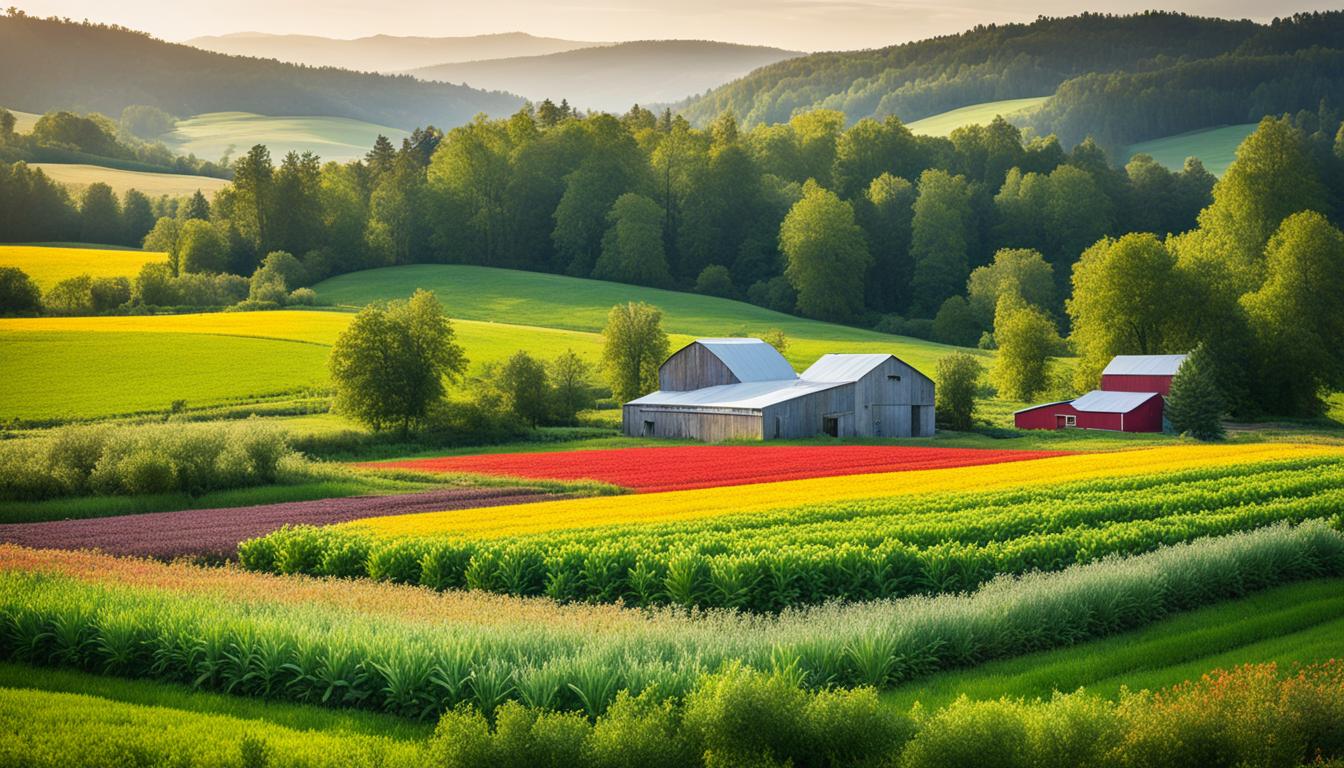
From 2020 to 2030, there’s a big push for saving soil. It’s all part of a global effort to keep our soils healthy. This work is key for better farming and fighting climate change. It shows how important soil life is for our future.
At a big meeting about the earth’s living things, the importance of soil creatures was clear. They’re vital for strong lands and helping fight the changing climate. The meeting urged countries to make sure soil life is safe and used wisely in farming. It’s a big step towards making food and farming more sustainable worldwide.
With these new plans, countries are working to make farming more resilient and lasting. This way, our farms can better handle the effects of a changing climate. It marks a big change in thinking, showing the world is serious about protecting soil life in farming.
The Convention on Biological Diversity (CBD) plays a key role in protecting the planet’s rich life. It started on 22 May 1992 and officially began on 29 December 1993. This important treaty was joined by 168 countries when it began. Its first meeting happened in the Bahamas from 28 November to 9 December 1994.
The CBD is crucial for tackling global environmental issues. Its primary aims are to conserve biodiversity, promote its sustainable use, and ensure fair benefit sharing from genetic resources. Over 170 countries have agreed to these aims by October 1998. This shows its wide reach and importance around the world.
The CBD aims to use biodiversity wisely and make sure everyone benefits fairly from it. It wants to keep the variety within and between plants and animals alive. These efforts are vital for practices like sustainable farming and careful use of the land.
The CBD sees the importance of earth’s underground life in farming. It encourages ways of farming that work with nature. This means growing many types of crops and keeping the wild plants around. Such farming methods help ensure there is enough good food for everyone, and they help keep the earth healthy. Also, it supports the role of small farmers and their wise ways of farming. This helps nature and the farmers who depend on it.
It is vital to understand how biodiversity and sustainable farming are linked. Biodiversity helps ecosystems be strong and lasting, not just for farming but for the environment’s health. It goes beyond just growing food. It includes making the land and soil better, as well as other benefits that help farming last longer.
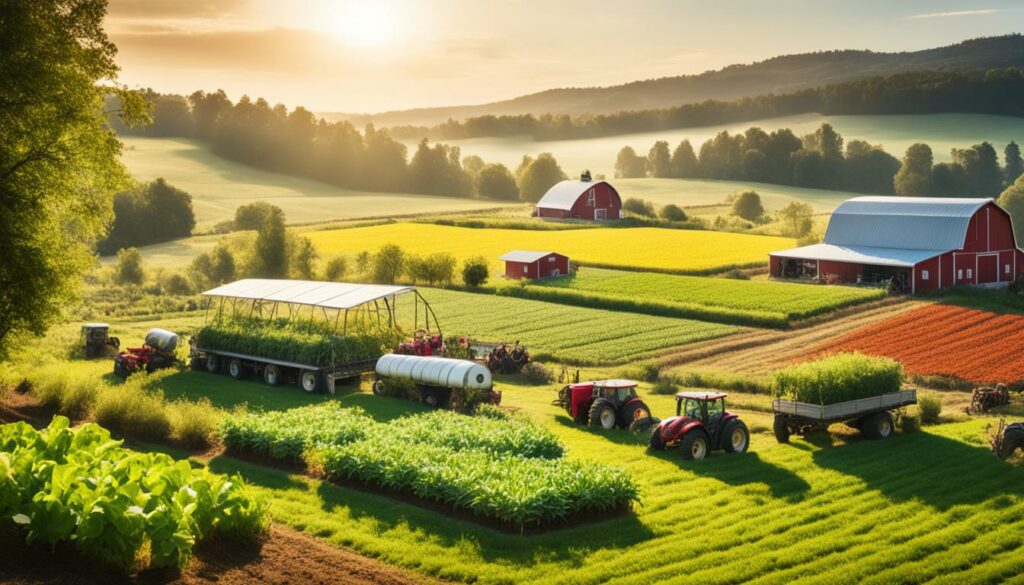
Biodiversity gives us important ecosystem services like controlling pests, pollinating, and cycling nutrients. This means farmers don’t need as many chemicals, which is better for the planet. Ecosystems are tougher against climate change and other problems because of the variety of life they contain.
Biodiversity is key to making soil rich and able to grow crops well. Many different organisms in the soil do important jobs. They break down waste and help plants get the food they need. This makes farming better and able to keep going for the long term.
Facts show sadly that biodiversity is decreasing fast. People are causing many species to die out and nature to suffer. Yet, there is hope. Groups including the Convention on Biological Diversity and the FAO work to save biodiversity in farming, showing its huge importance.
| Issue | Impact |
|---|---|
| Species Extinction | 1,000 times the natural background rate |
| Habitat Loss | 41% of mammals may lose half their habitat |
| Biodiversity Declines | 70% decline in populations of monitored species since 1970 |
| Wetland Destruction | 85% of carbon-absorbing wetlands destroyed |
Efforts to save biodiversity are making a difference. They show we can grow food and protect nature at the same time. This means healthier land, more crops, and ensuring we can keep feeding the world in the future.
The Convention on Biological Diversity (CBD) is focused on merging essential farming actions. This merging is for the long-term benefit of soil life diversity. It’s all part of a big plan stretching from 2020 to 2030. This plan is under the International Initiative for the Conservation and Sustainable Use of Soil Biodiversity.
The CBD pushes a variety of farming methods that keep the soil and its life healthy. It includes things like:
Old farming knowledge is key in what the CBD wants to do. It sees the real worth in the wisdom of the past. So, it mixes this wisdom with new ways to farm sustainably.
Also, getting more people to know and care about soil life is crucial. This means teaching and sharing new tech with poorer countries and others in need. The goal is to help them use greener farming techniques and improve their land.
Soil biodiver{s}ity is key for good farming and the enviro{n}ment’s health. It helps with lots of things like how nutrients move around, storing carbon, and keeping the world’s tempera{t}ure right. These creatures in the soil also help plants grow strong and make sure there’s enough water around. Using this biodiver{s}ity right is crucial for farms to stay healthy and the land to stay green.
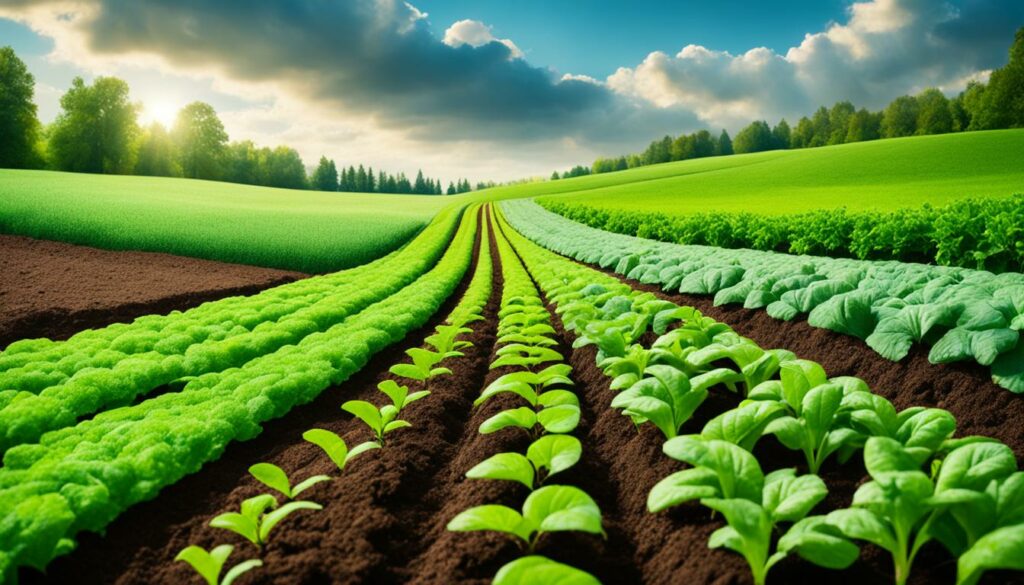
Keeping soil biodiver{s}ity healthy is vital for farms to work well. All the tiny bugs and critters in the dirt do jobs like helping with nutrients and keeping the soil in good shape. But, if the soil gets too worn out, we could face big problems with feeding people and keeping the planet safe. That’s why we have to make the soil’s health a top pri{o}rity.
There are many hurdles in saving soil biodiver{s}ity, from pollution to losing homes and climate change. These make some species disappear up to 1,000 times faster than before, all thanks to what people do. Less biodiver{s}ity makes it hard to farm sustainably. Back in April 2002, there was a big promise to stop this loss. But, today, plants and animals are still dying off too quickly, risking the land and our food.
To fight these issues, there are smart ways to keep soil life rich and well. A plan from the Convention on Biological Diversity started in March 2006 aims to spread the word and get soil health into rules. Also, more folks are learning to farm with nature, not chemicals, and using old farming tricks. These actions help keep the soil full of life, which is good for farms and the earth.
| Key Aspect | Action Taken |
|---|---|
| Initiative Establishment | March 2006 by decision VIII/23 |
| Conservation Goals | Raise awareness, integrate into policies |
| Management Practices | Eco-friendly farming, traditional knowledge |
| Biodiversity Loss Drivers | Habitat loss, pollution, climate change |
| Global Commitments | April 2002 to reduce biodiversity loss |
Keeping soil rich in life is key for farms to work well and the world to stay healthy. The Convention on Biological Diversity (CBD) and many others say saving soil life is very important. They want it to be a big part of how we do farming all over the world.
The Global Soil Biodiversity Observatory (GLOSOB) is a big move to watch and help soil life. It was started by countries working together. The goal is to make sure the world knows how to look after soil life. Everyone from scientists to people who use the land are joining in. GLOSOB started at the UN Biodiversity Conference in December 2022.
The United Nations also has a special goal to make nature better over the next ten years. This matches well with what the CBD wants for soil life. They say we should use science and what we already know. This way, the tiny life in the ground can keep doing important jobs. These jobs help plants grow, keep the ground healthy, and even help fight climate change.
We still don’t know much about the millions of life forms in soil. But, we do know losing them is a big threat to our food. Finding out more through big projects can help. We’ll learn how critical soil life really is. This can lead to smarter ways of farming.
The work of GLOSOB and the CBD is very important. They are leading a big plan to save soil life over the next decade. This shows that many countries and groups are working together. They want to protect our soil. This is for us and for those who come after us.
These big world plans are making farming better for nature and food. By protecting soil life, we can make sure the Earth stays productive. Everyone working together is the key to keeping our landscapes alive and working well.
The 2020-2030 Soil Biodiversity Plan of Action is crucial for the CBD soil biodiversity initiative. It aims to merge soil biodiversity into farming. This is in step with the main Post-2020 Biodiversity Framework.
The plan has clear targets. It aims to better save, fix, and wisely use soils.
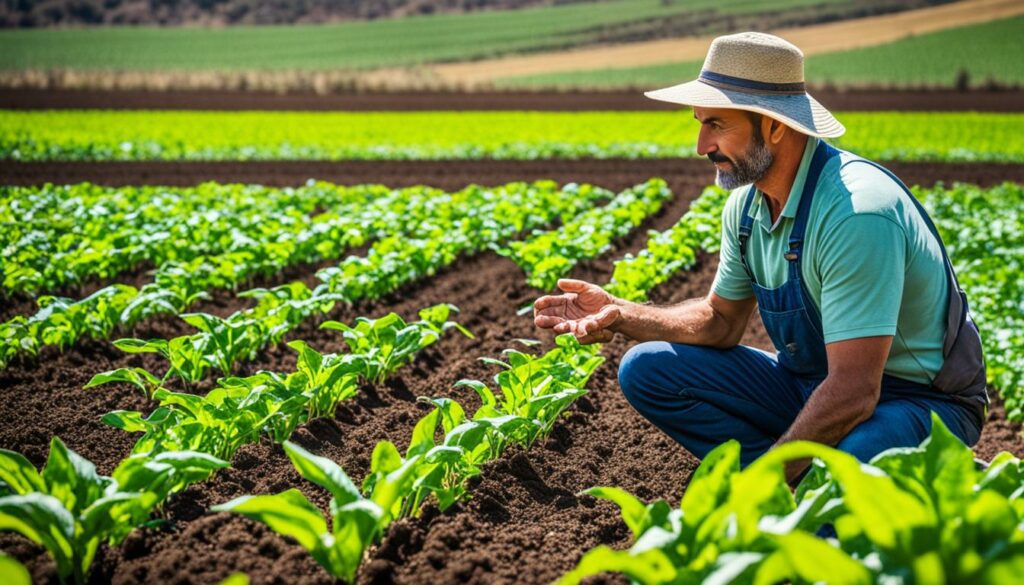
The draft action plan has six vital parts. They cover its beginning, its goals, what it includes, what countries should do, and how to support these actions. A key report from the United Nations’ Food and Agriculture Organization also highlights the significance of soil health.
The plan pushes for the Parties to make important decisions. It highlights the soil’s key part in farming that lasts. Countries are asked to fight the main causes of soil harm. They are also called on to make tools for gathering soil biodiversity facts, keep an eye on soil life, and do a big check-up on soil life around the world.
It also calls on schools, research teams, and local groups to boost what we know about soil life. It asks wealthier countries to aid in money and tech sharing for research. This will help keep farming methods good for the earth, worldwide.
The Executive Secretary’s job includes telling important UN groups these soil plans. This joined-up way of working stresses how important it is to bring back natural functions in the earth. It also shows the CBD soil biodiversity initiative continues to work hard for our earth’s land.
The CBD promotes farming methods that are both productive and Earth-friendly. These techniques include agroecology, organic farming, and using green practices. Each method helps achieve the goals of sustainable agriculture in its own way.
Agroecology applies nature’s rules to farming, encouraging a mix of crops. This approach boosts the land’s health and makes farms less fragile. It also cuts down on the need for harmful chemicals.
The importance of agroecology was highlighted at a major conference in Leipzig. It was agreed that these methods are key for the future of farming. Agroecology can make farming both more sustainable and productive.
Organic farming is growing fast, with the number of producers doubling in recent years. It avoids synthetic chemicals, focusing on natural methods to keep the soil and the environment healthy. The CBD sees organic farming as a key part of protecting biodiversity.
Organic farming’s impact is felt far and wide. It reduces harm to land, water, and living creatures. This leads to more diverse ecosystems and supports the rights of countries to control their own food sources.
Green farming mixes new technology with old wisdom to use resources wisely. Precision farming and careful water use are part of this. So is using renewable energy on farms. These smart methods keep farming sustainable.
The CBD supports farming practices that use a wide range of solutions. They not only save nature but also teach people about using nature wisely. The UN’s food group says these efforts are vital to protecting our farming future.
By following these practices, farms take good care of nature while staying productive. This ensures we have enough to eat while saving our planet’s health.
| Category | Global Adoption |
|---|---|
| Agroecology Practices | 29% of farms |
| Organic Farming Methods | 2.8 million producers |
| Green Farming Techniques | Integrated globally |
Small-scale farmers play a huge part in saving our planet. They grow food using methods passed down for generations. These methods keep the soil alive and help various plants and animals thrive. In fact, they provide between 50 and 70 percent of the world’s food, more than big farms.
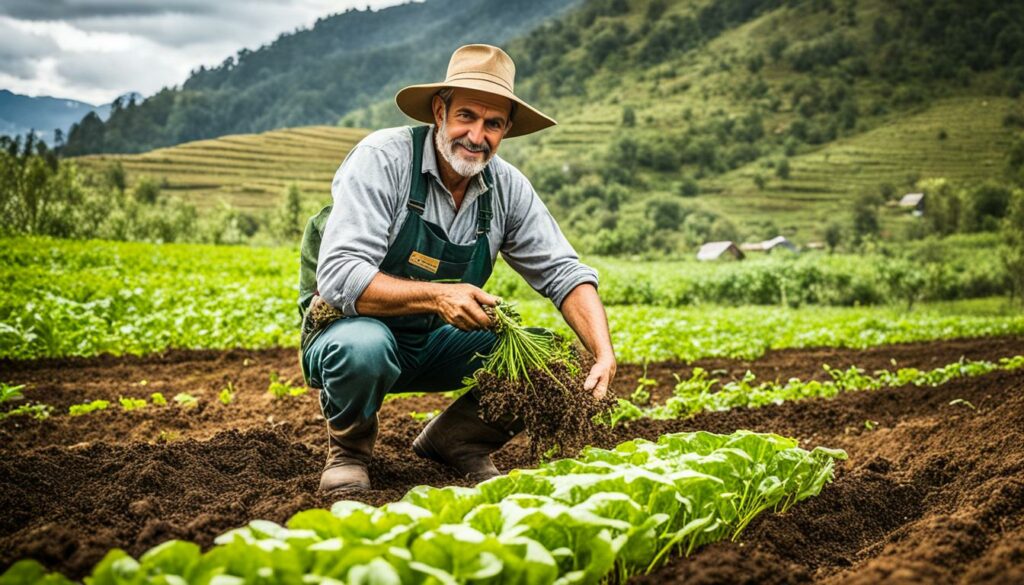
Small-scale farming impact is truly massive. Around 90 percent of the world’s farming is done on small farms. This shows how important they are for food safety. Especially in poorer areas, most farms are very small. Despite their hard work, many struggle to make ends meet, earning very little.
The CBD, or the Convention on Biological Diversity, sees promise in these farmers. Their way of farming with various crops and without much modern stuff is seen as vital for saving our plants and animals.
Helping family farm support is key to making small farms contribute more to saving nature. Most farms are small but have less space for growing food. By giving them help, we can make these farms more efficient and friendly to the environment. The CBD focuses on helping these small farmers in underdeveloped areas. Their goal is to combine old and new ways to keep our nature safe, which is good for food everywhere.
| Role/Impact | Statistics |
|---|---|
| Contribution to Global Food Supply | 50-70% |
| Classification as Small-Scale Farms | 90% of 570 million farms |
| Poverty among Small-Scale Farmers | Large portion of 880 million people |
| Farms Less than a Hectare in Developing World | 75% |
| Biodiversity Preservation | 77% of Studies Show Greater Biodiversity |
With help, small farmers can do even more for nature. By supporting them and making them part of bigger plans, we’re protecting our planet. This doesn’t just save animals and plants. It also means we’ll have good, lasting ways to grow food in the future.
Implementing good strategies for saving biodiversity in farming is key. This helps counteract species loss caused by things like losing habitats and climate change. Making sure agricultural policies match national strategies is crucial. This responds to the goal of cutting down biodiversity loss set by the Convention on Biological Diversity (CBD).
Every May 22nd is the International Day for Biological Diversity. It shines a light on the need to act and protect our diverse life forms. With 190 countries working towards the CBD’s aims, a global effort is clear.
Agriculture can both harm and help biodiversity. If farming methods are friendlier to biodiversity, they can use the benefits ecosystems offer. Such as keeping the soil healthy, controlling pests, and managing water. These are key for making farming sustainable.
Agriculture and biodiversity help each other out. For this mutual benefit, countries need to work hard on preserving biodiversity in farming. This includes making sure that farming policies encourage practices that help biodiversity.
The Programme of Work of the CBD covers various topics. These include pollinators, soil life, and plant genetics. To work on these well, a workshop noted four key steps. These include getting the right info, doing more research, educating people, and developing new policies.
Here’s an overview to see how different farming approaches help support better agriculture policies:
| Biodiversity-Friendly Farming Frameworks | Contribution to Sustainable Agriculture Policy |
|---|---|
| Agroecology Practices | Promote crop and livestock diversity, enhancing ecosystem services and resilience. |
| Organic Farming | Reduces synthetic inputs, conserves soil health, and sustains biodiversity. |
| Integrated Pest Management | Minimises chemical use, preserving beneficial species and ecosystem balance. |
| Conservation Agriculture | Improves soil structure, water retention, and biodiversity through minimal tillage and cover crops. |
By using these methods, and making sure our policies help save biodiversity, we support a better future for both people and nature. This approach offers benefits for the economy and society. Plus, it helps keep our natural world healthy for farming and biodiversity.
The Convention on Biological Diversity (CBD) has set up detailed systems for checking on and sharing progress in saving nature. These tools are key in making sure goals are clear and that everyone is trying their best. They help keep an eye on how well the big plans are going.
“The Plan of Action (2020-2030) for the International Initiative for the Conservation and Sustainable Use of Soil Biodiversity was adopted.” This comprehensive plan shows how important it is for countries to work together. They must protect and wisely use the living things in the soil in places like farms and other lands.
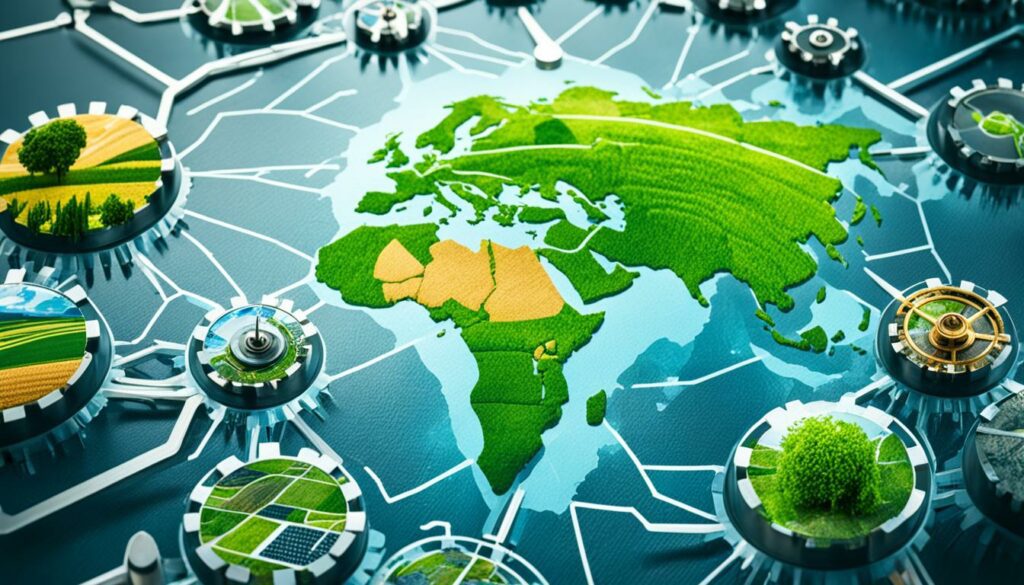
Helping countries do the needed research and sharing new tech is a big focus. This help is vital for making these checks work well. Also, it’s a big deal when countries say what they are doing and how it’s going. This builds a strong way to share what works and what doesn’t.
These shared reports are a big help in reviewing how well the CBD’s ideas are being put into action. Important groups like the Food and Agriculture Organization add a lot to our understanding of soil life. They help us see its challenges and what could be done to make things better.
| Monitoring Aspect | Description | Responsible Entity |
|---|---|---|
| Activity Reporting | Parties share details about their work to save biodiversity, on their own. | Each Country |
| Data Compilation | They give in their work and its results for everyone to check openly. | CBD’s Leader |
| Financial Support | It’s about getting money help for important bio projects from various supporters. | A Fund, Donors |
| Progress Evaluation | Checking in often to see how well the work is following set plans and meeting goals. | A Checking Group |
To do more, a group related to the UN suggested a detailed list of maps and data. This extra info is a big step in making the CBD review and plan better.
An important part of keeping track is focusing on local and native people, those who farm, and younger people. They are encouraged to be part of spreading the word and making sure everyone knows why soil life matters. This inclusive way makes the efforts stronger and makes sure everyone plays a part in saving our planet.
Getting financial help for biodiversity is key to boost conservation globally, especially in less wealthy nations. The Global Environment Facility (GEF) is a major player in this. It offers important funds to help these countries with their conservation efforts and use of biodiversity in a sustainable way.
The GEF is important for funding plans under the Convention on Biological Diversity (CBD). By February 8, 2024, the Global Biodiversity Framework Fund (GBFF) got promises for $219.2 million. Of this, $54.6 million has been given out by different countries and groups.
This includes Canada’s pledge of CAD 200 million, supported by signed agreements. Germany also promised EUR 41.7 million, keeping its word more than its agreement. However, the UK hasn’t formalized its GBP 10 million pledge with any agreements or payments.
Japan’s JPY 650 million pledge is also yet to see any agreements or payments. Luxembourg has promised EUR 7 million but hasn’t sorted out agreements or sent funds. Spain, on the other hand, made good on its EUR 10 million pledge with a recent payment.
The CBD stresses the importance of funding developing nations. The GBFF marked its first 2024 funding round, highlighting the start of its aid. It looks for projects with big global benefits and that fit well with policies.
Also, it keeps an eye on fair use for native and local communities. It aims to share funds equally. For example, more than 36% goes to island nations and the poorest countries. 25% is managed by groups like the World Bank, and there’s a hope to direct 20% to local communities by 2030.
It’s more than just a bucket for money. The GBFF is a big push for the world’s biodiversity needs. It offers significant grants for important projects.
The biodiversity loss drivers in agriculture are a big challenge. The Convention on Biological Diversity (CBD) is key in tackling these. It looks at many things hurting soil biodiversity. And it supports a mix of ways to help save it.
Climate change makes biodiversity loss way worse in farms. It changes rain patterns and ups extreme events. These changes put soil biodiversity at risk. This harms the health of entire ecosystems. The CBD’s policies ask countries to farm in ways that fight climate change.
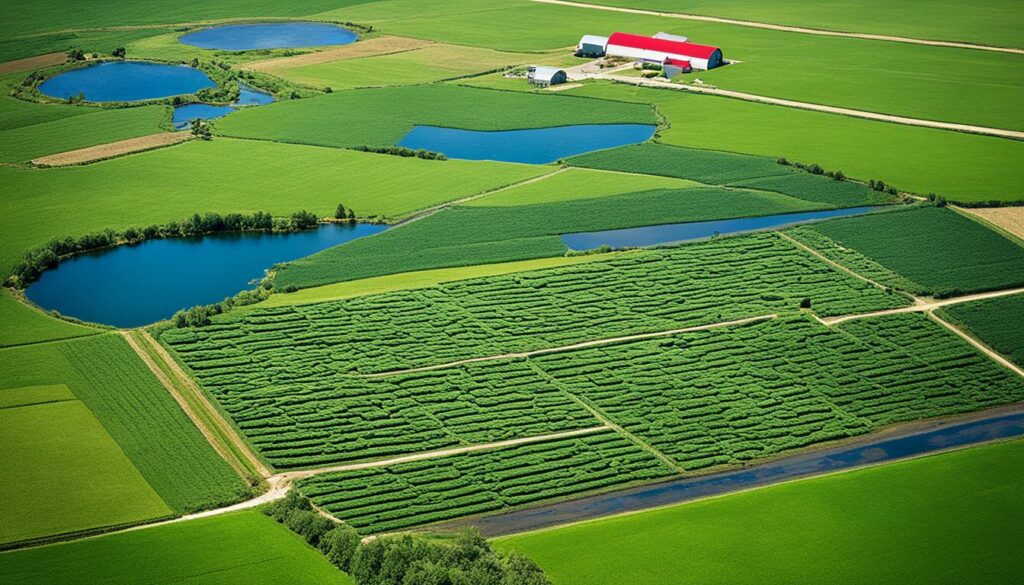
How we use land greatly affects biodiversity. More space for farming and cities means less room for wildlife. This loss of habitat is a big reason why biodiversity is dropping. The CBD promotes saving habitats and using land well. Their plan for 2020-2030 is all about saving soil biodiversity.
Fighting biodiversity loss requires action worldwide, not just locally. The CBD and many others are working together. They aim to make farming methods that keep nature safe and help it bounce back.
| Drivers | Impacts |
|---|---|
| Climate Change | Soil degradation, altered precipitation, increased extreme weather |
| Land Use Changes | Habitat loss, reduced species diversity, ecosystem destabilisation |
Biodiversity is crucial for making sure we have enough food. The Convention on Biological Diversity (CBD) talks a lot about how many different kinds of plants and animals help keep our food systems running. This is important for making sure everyone has enough to eat and the food keeps coming even when the weather is bad.
A lot of different plants and animals help us get the nutrients we need. The CBD says most farming today does not do enough for nature. By farming in ways that help nature too, the food we eat will be better for us. You might not know this, but 20% of the food around the world comes from other places. This shows we need to grow food closer to home and in many different ways.
Nature helps us make food that can survive bad weather and other problems. Because farming can harm our planet a lot, we must change how we farm. There are ways to farm that protect the earth and still give us plenty to eat. This kind of farming helps save the planet from getting too hot and creates homes for many plant and animal species. This is very important to make sure we’ll always have enough food, even if the weather changes a lot.
Investing in different ways to grow food is very important. For thousands of years, people have found new ways to farm, but now we must think about nature too. The CBD is helping us use what we know about nature to farm better. This will make sure our food future is safe and good for everyone.
| Aspect | Current Challenges | CBD Solutions |
|---|---|---|
| Food Security | Reliance on imported foodstuffs | Promoting local biodiversity |
| Greenhouse Gas Emissions | 30% from agriculture | Regenerative practices |
| Ecosystem Functions | Only 18-33% met | Enhancing semi-natural habitats |
The Convention on Biological Diversity (CBD) focuses on saving nature in agriculture. It needs a smart, future-looking plan. This plan needs money and everyone working together. The world is losing plants and animals fast. We must act now to save them.
Nature is key for farming to keep going well. It helps make sure we have enough food, stay healthy, and can work. But, countries have not done a lot to protect nature in farming. We need to make sure that farming, trade, and fishing focus on helping nature.
The CBD wants farmers to use ways that help nature and people. These ways should also make money and support society. By farming smartly and thinking ahead, we can fight climate change and keep nature strong. This is a big job that we must all do together.
The CBD is a global agreement. Its goal is to protect biological diversity. It helps in making use of resources sustainably and fairly. This includes promoting farming that is friendly to the environment and conserving the life in the soil.
The CBD supports earth-friendly farming methods. It encourages using natural practices over chemical ones. This helps farmers produce food in a way that protects the land.
Soil life is key for fertile and healthy soil. It makes nutrients available to plants and keeps them healthy. Lots of variety in the soil means better food growing conditions and coping with climate change.
The CBD backs many green farming ideas. This includes looking after the soil well and using farming methods that don’t harm nature. These methods help farms thrive in a way that is good for the planet.
The CBD values old farming know-how. It recommends mixing new and old farming ways. This is to ensure farming today is as good for the land as it is for producing food.
Helping the soil stay alive faces many hurdles. From pollution to too many chemicals and changes in how land is used. Tackling these problems needs everyone to work together for better soil and life in it.
The 2020-2030 Plan aims to put looking after soil life at the heart of farming. It wants to keep soil’s living part healthy. This effort is part of a bigger plan to make sure nature stays strong and resilient.
Small farmers do a lot to keep the land and soil diverse and healthy. The CBD applauds them and helps their good farming ways spread. Their efforts support nature’s variety.
The CBD offers help for saving nature through funds like the Global Environment Facility. It mainly helps poorer countries. This support aids in guarding soil’s life and making farming there better and greener.
Things like climate change and changes in how land is used hurt nature. The CBD pushes for green farming and bringing back nature places. Its aim is to keep the land productive while also protecting nature.
Nature’s variety keeps us fed and ready for hard times. Many plants and wild foods mean we can eat well. It also helps farms hold up against bad weather and continue to feed us in a changing world.